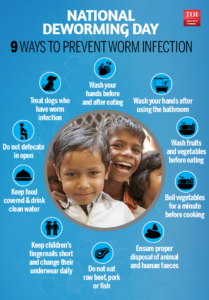A powerful National Deworming Day is an initiative by (MHFW) the Ministry of Health and Family Welfare. This is to focus on reducing the rate of parasitic worm infection in our tier-2/3 cities and Rural Areas also. This is affecting more than 2.4 million children every year in India. The First campaign was launc
hed in Feb-2015, which is as a part of National Health Mission with the m
ission to deworm all the children between the ages of 1 to 19 Yrs.

The day is regularly celebrated nationally. To make success on ground level, MHA is distributing free deworming-tablets to all pre-schools, schools and also distributing through anganwadis worker network
s. These tablets are tested followed by the Stick Pharmacy Standard. Although these are absolutely safe for c
hildren but may carry some side effects like vomiting; nausea, and diarrhea.
As per the medical science, there are lots of parasitic worms that can stay in the human body. These worms can lead to a cause of an infection; that can usually lead to symptoms like nausea, stomach ache, fever, swelled-face and, diarrhea. The infection interface can be a serious issue for mental and physical health for children. That can put their future at risk.
The most 5 common types of worms are:
“What worms commonly cause infection?”
When it comes to parasitic infection, flatworms and roundworms are the likely culprits. These two types of parasitic worms can be found in a variety of habitats and aren’t always visible to the naked eye.
Tapeworm
You can get a tapeworm by drinking water contaminated with tapeworm eggs or larvae. Raw or undercooked meat is another way these flatworms can find their way into people.
Tapeworms embed their heads into the intestinal wall and remain there. From there, certain types of tapeworms can produce eggs that migrate to other parts of the body.
A tapeworm looks like a long, white ribbon. They can grow up to 50 feet long and live in a human for up to 30 years.
Flukes
Flukes are a type of flatworm. People are less likely than animals to become infected with flukes. Raw watercress and other freshwater plants are the main sources of flukes in humans. You can also get infected when you drink contaminated water.
They make their home in your intestines, blood, or tissues. There are many varieties of flukes, none reaching more than a few inches in length.
Hookworms
Hookworms are transmitted through feces and infected soil. The most common way to make contact with this type of roundworm is to walk barefoot on soil infested with hookworm larvae, which can pierce the skin.
Hookworms live in the small intestine, where they attach themselves to the intestinal wall with a “hook.” They’re usually less than half an inch long.
Pinworms (Threadworms)
Pinworms are tiny, fairly harmless worms, but they’re quite common in children. These roundworms live in the colon and rectum. The female lays eggs around the anus, usually during the night.
The eggs can survive on bedding, clothing, and other materials. People get infected when they touch the eggs and end up putting them in their mouths. The eggs are so small you can even breathe them in if they become airborne. They’re easily passed among children and caregivers or in institutions.
Trichinosis worms
Trichinosis roundworms are passed among animals. The most common way humans get trichinosis is by eating undercooked meat that contains the larvae. The larvae mature in your intestines. As they reproduce, those larvae can travel outside the intestines into muscle and tissue.
What are the symptoms of parasite infection?
It may be hard to believe, but you don’t always know when you have an uninvited guest inside you. You may not have any symptoms, or they may be quite mild.
The symptoms that you could have included:
• nausea
• lack of appetite
• diarrhea
• abdominal pain
• weight loss
• general weakness
In addition, tapeworms can cause:
• lumps or bumps
• allergic reaction
• bacterial infection
• fever
• neurological problems such as seizures
It may take weeks or months to notice additional symptoms of fluke infection. These may include:
• fever
• fatigue
Additional symptoms of hookworms include:
• itchy rash
• anemia
• fatigue
As trichinosis worms travel through the bloodstream and enter other tissue or muscles, they can cause:
• fever
• swelling of the face
• muscle pain and tenderness
• a headache
• light sensitivity
• conjunctivitis
How does the infection spread?
The infection generally can be transferred while you intake a worm, this cause in form of larvae and or even its eggs. There are other ways to spread the worms such as drinking contaminated water, uncooked or partially cooked meat, infected soil and also feces of humans & animals.
For the clinical findings, the consultant can be prescribed to performed faecal test, endoscopy, blood test, imaging tests and tape test. These tests performed in Labs to know the exact type of infection.
How to prevent?
the prevention of parasitic infection is much easy. This is always advised to be cautious about high cleanliness and hygiene to avoid such infections. The above infographic shows 9 easy ways you can prevent worm infections.
 You must read about World Class OPD Health Plan
You must read about World Class OPD Health Plan
Courtesy / Disclaimer:
References are taken Healthline, & Times of India. This blog is published for social cause only. Hence RIHL is not liable for any error or claim for originality or similar in nature.

